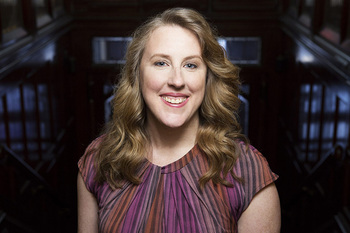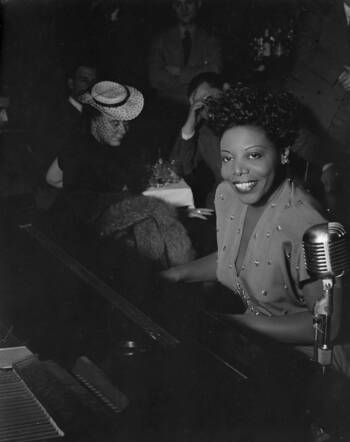
Deanna Witkowski (University of Pittsburgh) is a pianist, composer, and doctoral student in jazz studies. She received a Mother Theodore Guerin Research Travel Grant from the Cushwa Center in 2021 for her project, “Writing Friendships: Letter Correspondence between Jazz Pianist Mary Lou Williams and Women Religious from 1961–1981.” In September, Philip Byers and Witkowski corresponded about her research.
Philip Byers: Your project, “Writing Friendships,” examines correspondence between the jazz pianist and composer Mary Lou Williams and several women religious. Give us some brief background—who was Mary Lou Williams, what do we already know about her relationship to Catholicism, and what new information does your project aim to illuminate?
Deanna Witkowski: Mary Lou Williams (1910–81) was a jazz pianist, composer, and one of the major innovators in the history of jazz. In her 60-year career, her music not only spanned many different eras of jazz, but was on the cutting edge of whatever sound was coming next. Mary defined herself as being an experimentalist: while the blues defined the central roots of her music, she had an expansive view of what the blues was both in terms of musical form and “spiritual feeling.” Her mantras of “jazz is healing to the soul” and “jazz is love” permeated all of her work as a performer, educator, and composer.
Mary was also an idea-maker and a force of nature (in fact, Force of Nature is the title of my all-Williams recording coming out in January). She was persistent and determined in following her artistic vision and in creating networks of friendship and support.
Mary’s mid-life conversion to Catholicism and her subsequent sacred music compositions, including three jazz Masses, are well-reported. Usually there are a few particular names of priests and musicians who helped Mary find her path of integrating her music and her faith. What I’ve found fascinating in my research are the many friendships that Mary developed with women religious and how those friendships provided behind-the-scenes support for her work and her spirit.
I also have a unique perspective on Mary’s musical output because I’ve performed her music for more than 20 years. And, like Williams, I’m both an adult convert to Catholicism and a liturgical jazz composer. Because of these parallels, I’m able to bring particular nuances to my recounting of her spirituality. I also empathize with the persistent work that Mary undertook to bring her sacred music to many different communities and with her work in forming youth choirs to sing her Mass settings in different parishes.
PB: How did you become interested in Williams as a subject? What first drew you to her story?

DW: In 2000, the late pianist-educator Dr. Billy Taylor invited me to perform at the Kennedy Center’s Mary Lou Williams Women in Jazz Festival. At the time, I knew Williams’ name and almost none of her music. I decided that if I was to play at this festival, I had the responsibility to listen to Williams’ music and to learn her story. Right around that same time, the first biography of Williams, Linda Dahl’s Morning Glory, had just been published. When I got to the section of the book chronicling her conversion and liturgical music output, I was immediately heartened: I’d just composed my first jazz Mass for All Angels’ Church, an Episcopal church in Manhattan where I was then serving as music director. I checked out Mary Lou’s Mass and visited her archives at the Institute of Jazz Studies at Rutgers University, where I listened to homemade recordings of her first two Masses. I also started checking out her later small-group recordings such as her 1974 album, Zoning, and was amazed at how modern she sounded, yet how she always had a deep sense of swing no matter the style. I felt emotionally connected to Mary’s playing and composing and knew that I’d found a companion of the spirit.
PB: In your grant proposal, you recount how Williams and Sister Martha Mulligan developed a “soul friendship.” Can you elaborate on that for us? What did this soul friendship involve, and how did it influence Williams’ life and career?
DW: One of the most satisfying aspects of my research has been reading boxes and boxes of letter correspondence—primarily letters sent to Mary, but some that she sent as well—to fans and friends, which included men and women religious. Through these letters, I was able to determine that Mary made what was likely her first spiritual retreat in the late 1950s at a Cenacle retreat center in Mount Kisco, New York. On that retreat, she met Sister Martha Mulligan, a Cenacle sister who had helped to arrange Mary’s stay. One of the archival boxes at Rutgers includes letters written over a 17-year period between Sister Martha and Mary. In looking through other folders of letters from women religious, I realized that every time Mary would go on a retreat, she would meet at least one sister with whom she would strike up a friendship. She would then stay in touch with that sister via letter, whether she was on the road in Copenhagen or at home in her Harlem apartment. Mary sent her recordings to Sister Martha to share with her community, and Sister Martha preserved newspaper clippings of Mary’s performances in a scrapbook. Both women asked each other for prayer: Sister Martha writes of her sister Helen’s death and consoles Mary in 1965 when Mary’s beloved spiritual confessor, Father Anthony Woods, S.J., dies. Often, Sister Martha comes to see Mary perform in Manhattan, and she prays for Mary in the Cenacle chapel when she is unable to be physically present.
I realized through my reading of these letters that, contrary to the usual narrative that states that the Catholic Church did not support Mary’s work (and, particularly, her sacred music), Mary crafted networks of support for her work—especially among women religious. Mary also had a deep friendship with Brother Mario Hancock, a Franciscan friar—and their letters extend over decades and are very personal. But because Mary often struggled with wanting to give away everything she had in order to help others in need—and this struggle sometimes meant that she stayed away from performing in order to devote herself to works of mercy—I believe that she particularly needed the support and encouragement of nuns. These women were able to continue to bolster Mary’s confidence that her music was a source of healing and joy for many, and they helped give Mary the courage to continue her work.
PB: You’re an accomplished musician in your own right—describe how your identity as a performer has shaped your research on Williams. What does your background reveal to you about Williams that other writers may not see?
DW: As a composer who writes choral music and as a pianist who plays both classical and jazz, I bring an understanding of what differently-trained musicians need to see in a musical score. This is why I’ve been working with the Mary Lou Williams Foundation to create a new edition of Mary Lou’s Mass that will soon be available to license for performance use. I’m now living in Pittsburgh, Mary’s hometown (which is a story in and of itself), and on October 24 I will also be giving a performance of Mary Lou’s Mass with a 12-voice choir and jazz quartet at Sacred Heart Church in Shadyside.
I also understand how difficult it can be to descriptively write about music in a way that anyone can understand. I expect that many jazz fans will be reading my biography, in addition to readers for whom Williams is a brand new subject. When I mention particular recordings in my biography, I try to focus on one or two particular characteristics of the recording that provoke a visceral or emotional response in myself and then convey that to the reader. I’m not big on memorizing a ton of names or dates of particular recordings (though this is important information for jazz historians): I want to write about the music in an attractive way that makes the reader want to go seek it out for herself.
PB: Your biography, Mary Lou Williams: Music for the Soul (Liturgical Press), hit the shelves in September. With that work already in front of the public, where do you imagine taking this project next?
DW: One of the main things I want to start doing more of is to work with choirs to present Mary’s sacred music—and my own—with my trio. Before the pandemic, I frequently traveled to churches around the country bringing together jazz and liturgy in communities where jazz was often not a regular part of the congregational repertoire. I want to come to a town and not only do a book reading but do a performance-reading where excerpts of the book lead into musical performance (as I did on September 16 at Con Alma, a Pittsburgh jazz club); then work with local church/choral directors to form a combined choir to sing Mary’s music both in concert and liturgical settings; then do a straight solo or trio performance doing Mary’s instrumental music. In February 2020, I gave a performance-lecture called “Jazz is Love: The Life & Music of Mary Lou Williams” at Fordham University. I can easily see doing all of the aforementioned work at Catholic—and especially Jesuit—universities. Mary’s story crosses so many boundaries between disciplines—gender studies, religious studies, African American studies, jazz studies—that I would love to be a guest professor or artist-in-residence at colleges where I can take an entire semester to teach a course on Mary and to present all of these different musical configurations. Mary believed that jazz belonged everywhere: in churches, schools, community centers, and on the street. I want to have the privilege of playing Mary’s music in all of these places.
Philip Byers is a postdoctoral research associate at the University of Notre Dame's Cushwa Center.